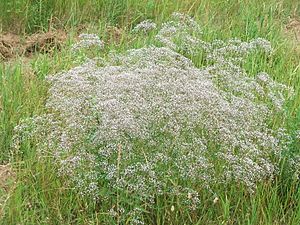Baby's breath facts for kids
Quick facts for kids Common Baby's-breath |
|
|---|---|
 |
|
| Gypsophila paniculata | |
| Scientific classification | |
| Kingdom: | |
| (unranked): | |
| (unranked): | |
| (unranked): | |
| Order: | |
| Family: | |
| Genus: |
Gypsophila
|
| Species: |
G. paniculata
|
| Binomial name | |
| Gypsophila paniculata |
|
Gypsophila paniculata is a type of plant often called baby's breath. It's a perennial plant, which means it lives for more than two years. You might have seen its tiny white flowers in bouquets, often used to fill out flower arrangements.
Contents
About Baby's Breath
This plant usually grows to be about 2 to 3 feet tall and just as wide. Its small, white flowers bloom from April to August. Baby's breath loves lots of sunlight, so it needs to be in a spot where it gets direct sun. It's a herbaceous plant, which means its stems and leaves die back to the ground at the end of the growing season. It doesn't have a woody stem above the ground like a tree or shrub.
Where Baby's Breath Grows
Baby's breath originally comes from Central Europe and Siberia.
Important Safety Information
It's important to know that baby's breath can be poisonous. The flowers are poisonous, and other parts of the plant are also poisonous when they are dry. If you handle the plant often, it can cause irritation to your eyes or inside your nose (called the nasal cavity). It might even cause asthma in some people. The plant can also cause a small skin irritation that usually goes away quickly. It's best to be careful and avoid touching or eating this plant.
Images for kids
See also
 In Spanish: Gypsophila paniculata para niños
In Spanish: Gypsophila paniculata para niños




